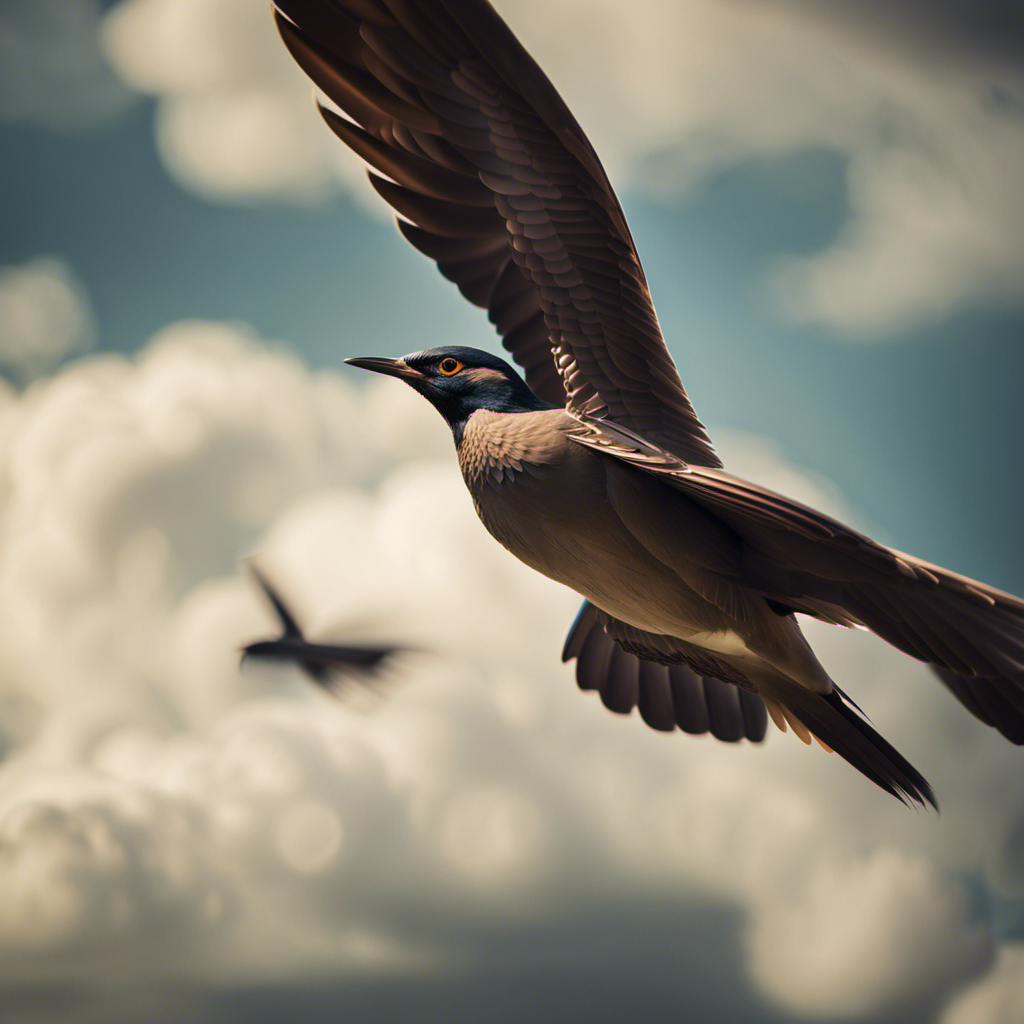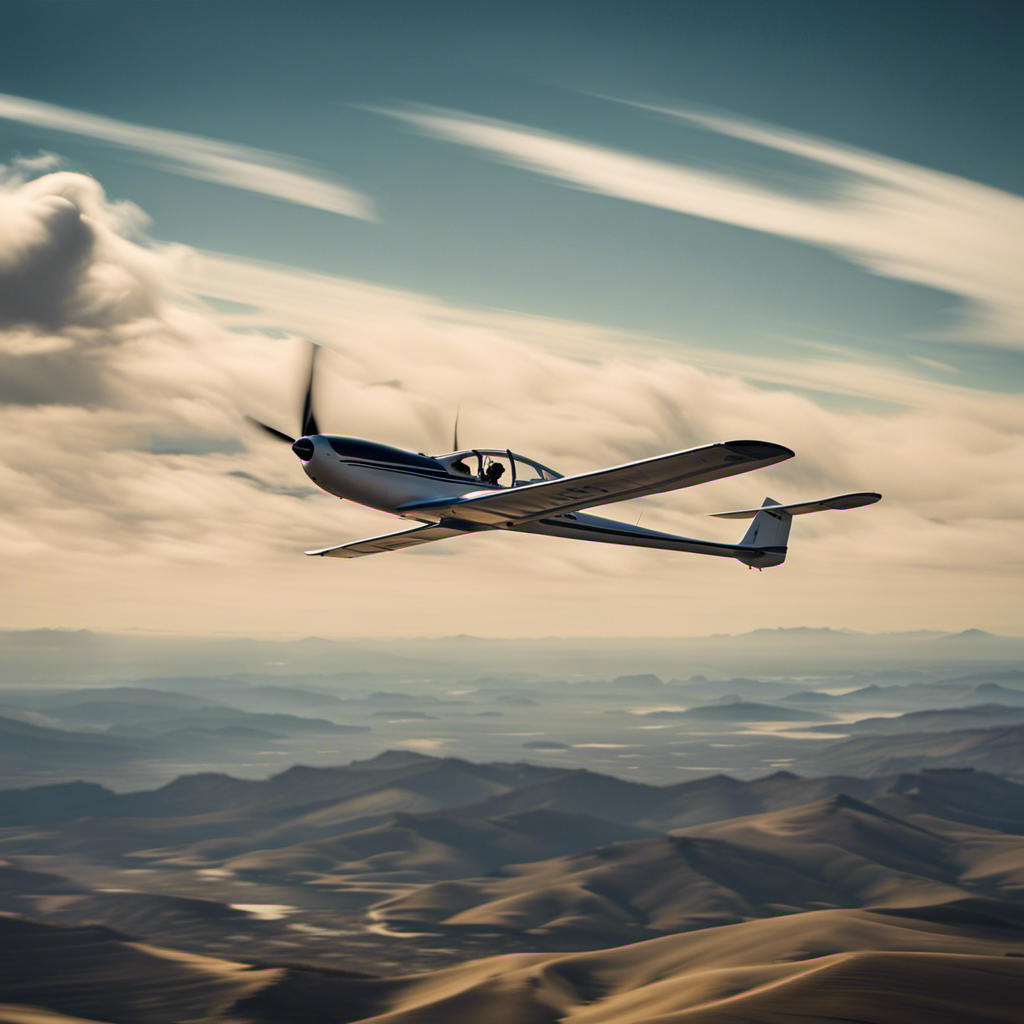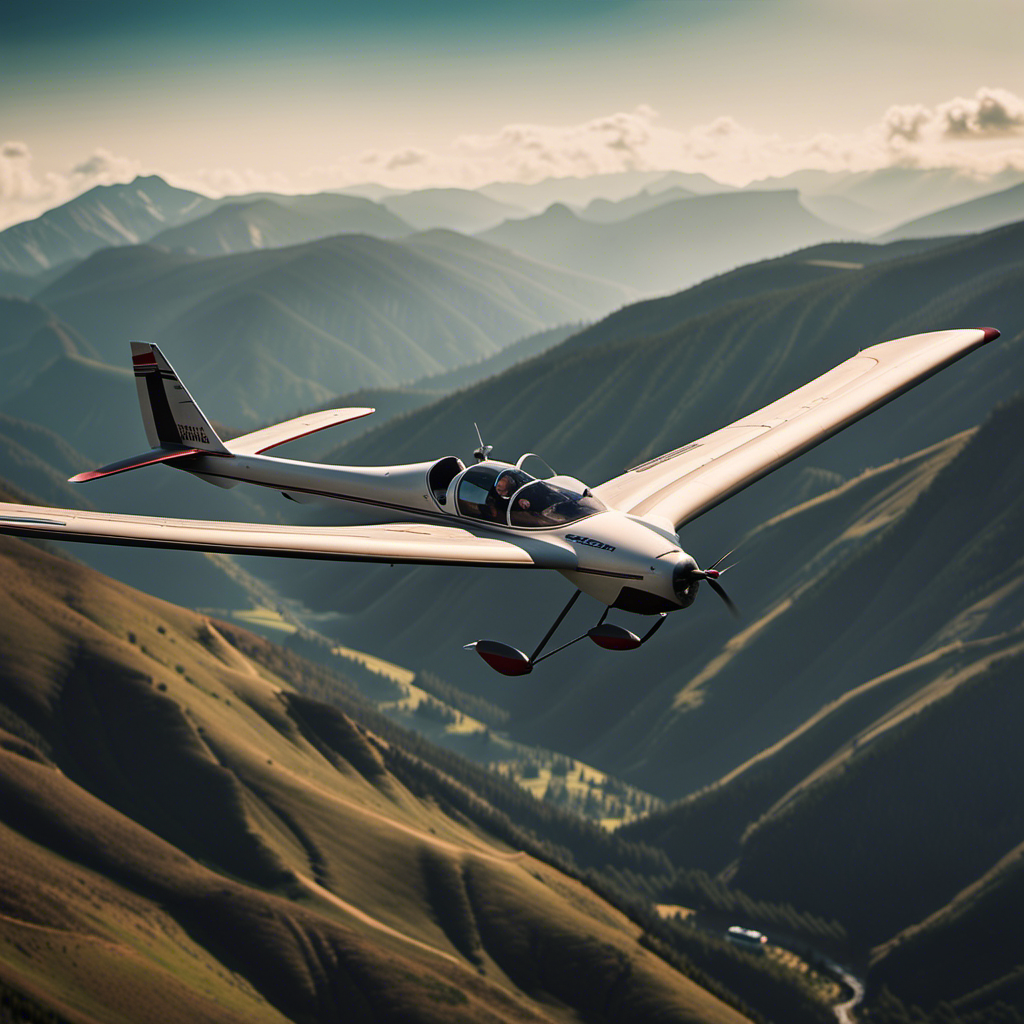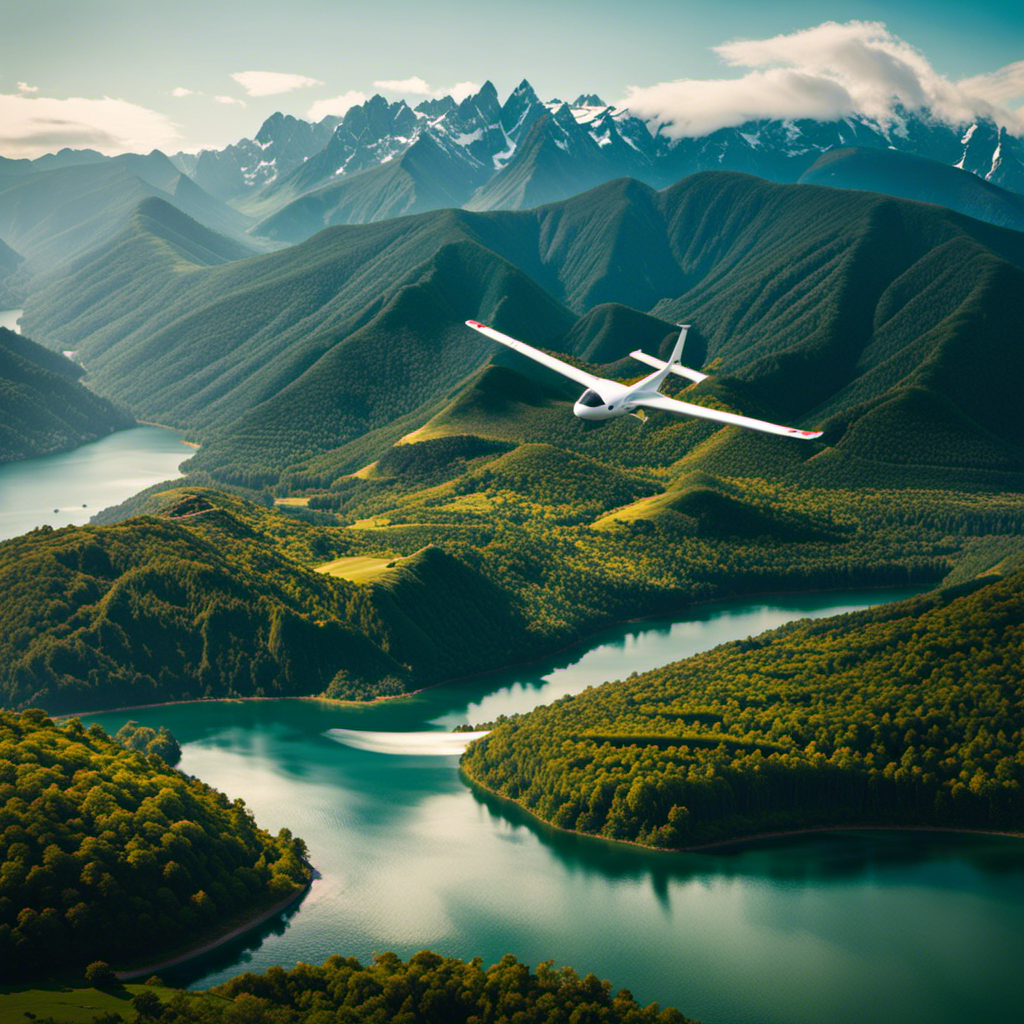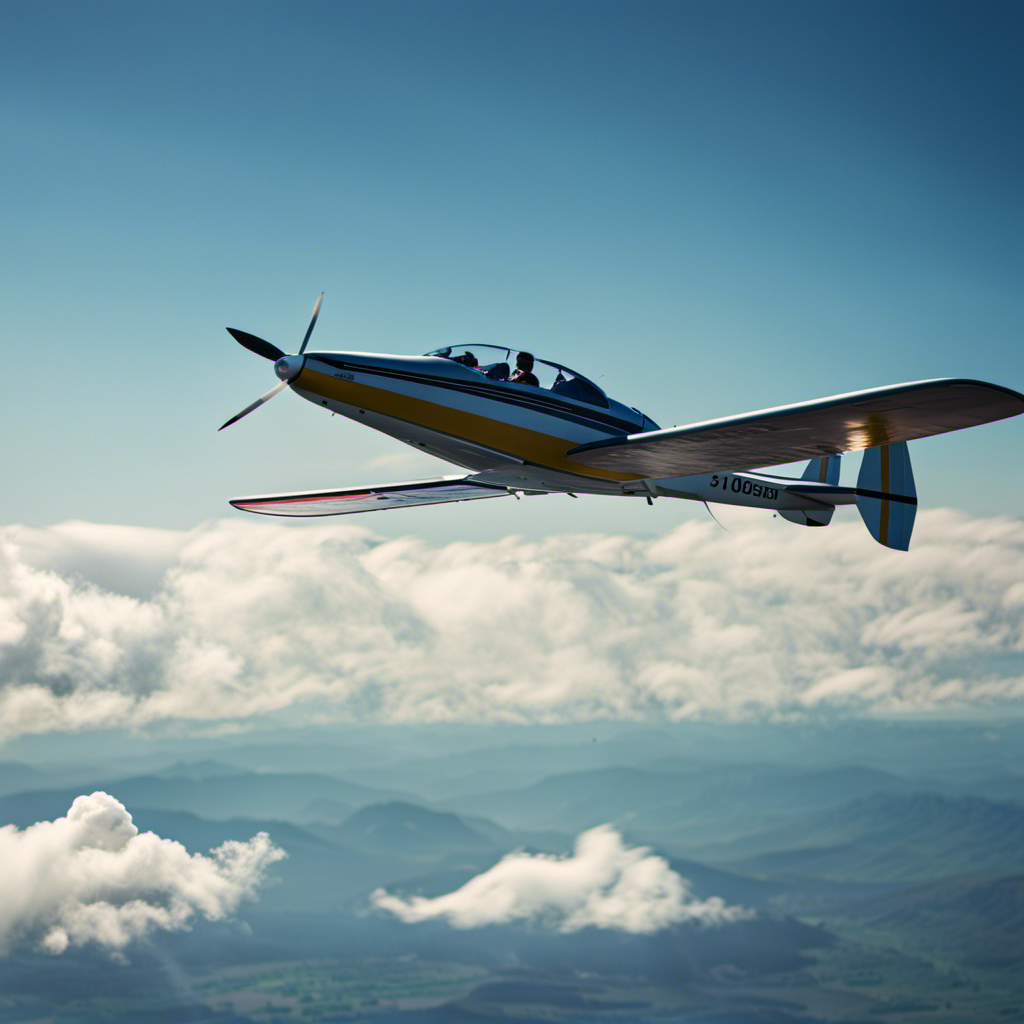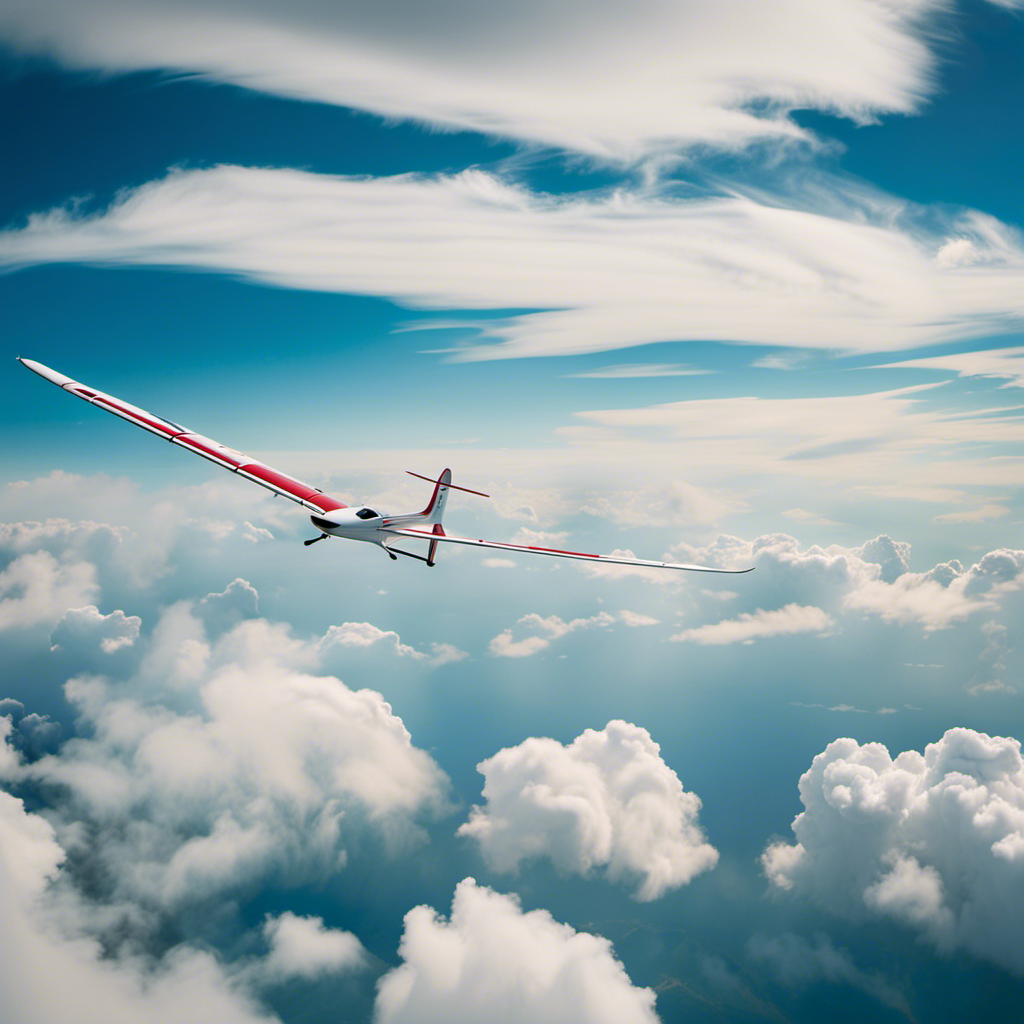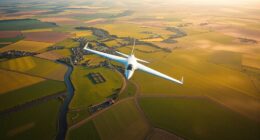You think there’s not much of a distinction between gliding and flying, huh? Well, let me tell you, my friend, it’s actually more intricate than you might think.
Gliding, with its reliance on wind currents and gravity, offers a unique experience that sets it apart from traditional powered flight.
In this article, we’ll delve into the nitty-gritty details of gliding, exploring its physics, different types of gliders, launching methods, and flying techniques.
Buckle up, because we’re about to take off into the fascinating world of gliding!
Key Takeaways
- Gliding is a form of aviation without an engine, relying on natural forces to stay aloft.
- Gliders have a high lift-to-drag ratio and are lightweight with a small wingspan.
- The physics of gliding involve lift generated by the interaction between wings and air, utilizing Bernoulli’s principle and Newton’s laws of motion.
- Gliding can be done using different types of gliders and launching methods, each with unique characteristics and considerations for safety and control.
Definition and Basics of Gliding
So, you’re wondering what gliding really is and how it differs from flying.
Gliding is a form of aviation where an aircraft, called a glider, is able to fly without an engine. Instead, gliders rely on the natural forces of the atmosphere to stay aloft.
Gliding techniques involve using rising air currents, such as thermals or ridge lift, to gain altitude and maintain flight. Gliding equipment includes a glider, which is a lightweight aircraft with a wingspan similar to that of a small airplane, and a cockpit for the pilot.
The glider is designed to have a high lift-to-drag ratio, allowing it to glide efficiently through the air.
Now that we understand the basics of gliding, let’s explore the physics behind this fascinating activity.
The Physics Behind Gliding
To understand the physics behind gliding, you’ll need to grasp the concept of lift and how it enables a glider to stay airborne. Lift is generated by the interaction between the glider’s wings and the air. The shape of the wing, known as the airfoil, plays a crucial role in creating lift. As air flows over the curved upper surface and the flat lower surface of the wing, it travels faster over the curved surface, creating lower air pressure compared to the bottom surface. This pressure difference generates lift, allowing the glider to overcome the force of gravity and stay aloft.
In order to further understand the physics principles and aerodynamics principles involved in gliding, let’s take a look at the following table:
| Physics Principles | Aerodynamics Principles |
|---|---|
| Bernoulli’s principle | Angle of attack |
| Newton’s laws of motion | Wing design |
| Drag | Center of gravity |
These principles play a vital role in determining the performance and behavior of a glider during flight. They help pilots manipulate the forces acting on the glider and optimize its flight characteristics.
Transitioning into the subsequent section about ‘types of gliders,’ it is important to note that understanding the physics and aerodynamics principles behind gliding serves as a foundation for exploring the different types of gliders available.
Types of Gliders
Understanding the physics and aerodynamics principles behind gliders is crucial for exploring the various types available. There are several types of glider designs, each with its own unique characteristics and benefits.
One common type is the sailplane, which is designed for soaring and can stay airborne for extended periods of time. Another type is the hang glider, which consists of a lightweight frame and a flexible wing, allowing the pilot to control the glider through body movements. Paragliders, on the other hand, are steerable parachutes that are designed for both soaring and descending.
The benefits of gliding include the ability to fly without an engine, the opportunity to experience the freedom of flight, and the chance to explore the beauty of the natural surroundings.
Transitioning into the next section about launching methods, let’s now discuss how gliders are launched into the air.
Launching Methods
When it comes to launching a glider, there are several methods that can be used.
The first method is aerotow, which involves a powered aircraft towing the glider into the air using a rope. This method allows for a controlled and precise launch, as the glider can be released at a desired altitude.
Another method is the winch launch, where a winch on the ground rapidly reels in a cable attached to the glider, propelling it into the air.
Lastly, there is the hill launch, which involves launching the glider from a slope or hill, taking advantage of the upward lift generated by the wind hitting the hill.
Each method has its own advantages and considerations, and the choice of launching method depends on various factors such as wind conditions and available equipment.
Aerotow
Aerotow is a method used to launch gliders using a powered aircraft. Glider clubs often employ aerotow as it allows them to quickly and efficiently get their gliders into the air. In an aerotow, the glider is connected to the tow plane by a cable, usually made of steel. Once the glider is securely attached, the tow plane accelerates down the runway, using its engine power to generate enough speed for both aircraft to become airborne.
Once the desired altitude is reached, the glider pilot releases the cable, disconnecting from the tow plane. This method allows gliders to reach higher altitudes and cover longer distances compared to other launching methods.
Now, let’s delve into another popular launching method: winch launch.
Winch Launch
After discussing aerotow, let’s move on to another method of launching a glider: the winch launch.
In a winch launch, a powerful winch is used to rapidly reel in a cable attached to the glider, propelling it into the air. This method requires careful attention to safety procedures and proper training.
Winch launch safety involves ensuring that the cable is strong and free from defects, and that the winch operator is experienced and trained in operating the winch safely. Additionally, the glider pilot must be trained in proper winch launch techniques to ensure a smooth and controlled ascent.
By following these safety protocols and undergoing winch launch training, glider pilots can safely and effectively utilize the winch launch method.
Now let’s explore another launch method: the hill launch.
Hill Launch
In a hill launch, the glider is launched from an elevated position on a slope, using the natural upward movement of air to gain altitude. This method is commonly used in gliding schools to teach beginners the basics of gliding. The table below provides a visual representation of the key elements involved in a hill launch:
| Key Elements | Description |
|---|---|
| Slope | An inclined surface that provides the necessary elevation for the launch. |
| Wind | The direction and speed of the wind are crucial for a successful launch. |
| Launch Point | The specific spot on the slope where the glider is released to begin the flight. |
| Air Movement | The upward movement of air along the slope, known as ridge lift, provides the lift necessary for the glider to gain altitude. |
Understanding these key elements is essential for a pilot to execute a safe and successful hill launch. It is a fundamental technique that sets the foundation for more advanced flying techniques and skills, such as thermalling and cross-country flying.
Flying Techniques and Skills
To improve your flying skills, you should focus on maintaining a steady glide and practicing precise control inputs.
Flying techniques play a crucial role in advanced maneuvers, allowing you to execute complex maneuvers with precision and finesse.
One important technique to master is the art of thermalling, which involves circling within a rising column of air to gain altitude. This requires keen observation of wind patterns and precise control inputs to maintain the desired turn radius and bank angle.
Another key skill is ridge soaring, where you exploit the wind blowing against a hill or mountain to generate lift. This technique requires constant adjustment of the glider’s position relative to the ridge to maximize lift and maintain a steady glide.
Gliding Competitions and Records
As a glider pilot, I’ve always been fascinated by the world of gliding competitions and records.
The World Gliding Championships, held every two years, showcase the pinnacle of glider racing and the skills of the pilots. These competitions challenge pilots to navigate complex courses and achieve maximum speeds while relying solely on the power of the wind.
In addition to championships, glider pilots also strive to set records for the longest flights and highest altitudes, pushing the boundaries of what’s possible in the world of gliding.
World Gliding Championships
The World Gliding Championships showcase the finest gliders from around the globe. This prestigious event brings together skilled pilots who compete in various categories, such as distance, speed, and accuracy.
One of the most impressive aspects of the championships is the longest glider flights achieved by these pilots. These flights can span incredible distances, with some pilots covering hundreds of kilometers without the use of an engine.
The pilots rely on thermal updrafts, ridge lift, and wave lift to sustain their flights and maximize their distance. The World Gliding Championships not only highlight the skill and expertise of the pilots but also push the boundaries of what is possible in gliding.
Now, let’s delve into the fascinating world of the longest glider flights achieved in history.
Longest Glider Flights
You’ll be amazed by the incredible distances achieved in some of the longest glider flights in history. Gliding techniques and skillful piloting are essential to cover vast distances without an engine. Here are three remarkable examples:
-
Steve Fossett: In 2006, Fossett set the world record for the longest glider flight, covering 1,864.9 kilometers (1,159.9 miles) over the Sierra Nevada Mountains in California. He utilized ridge soaring techniques, exploiting the wind patterns created by the mountain range.
-
Klaus Ohlmann: Ohlmann holds the record for the longest out-and-return glider flight, covering 3,008 kilometers (1,869 miles) in Argentina in 2003. He used wave lift, a phenomenon where wind encounters a mountain range and forms standing waves of rising air.
-
Jim Payne and Morgan Sandercock: In 2018, this duo flew 2,590 kilometers (1,608 miles) in a glider, using the Sierra Nevada wave system. They employed advanced meteorological analysis to find the optimal conditions for sustained flight.
These impressive glider flights demonstrate the incredible capabilities of human pilots and the effectiveness of various gliding techniques.
Transitioning into the next section about altitude records, let’s explore the heights reached by these skilled glider pilots.
Altitude Records
Klaus Ohlmann holds the record for reaching the highest altitude in a glider flight, soaring to an astonishing height of 15,460 meters (50,721 feet) in the Andes Mountains. Altitude records are an important part of gliding, showcasing the incredible capabilities of these aircraft.
Gliders are able to achieve such high altitudes due to their unique design and the skill of the pilot. The lack of an engine allows gliders to ride thermals, updrafts of warm air, to gain altitude. Pilots must carefully plan their flights, taking into account weather conditions and wind patterns to maximize their altitude gains.
These altitude records not only demonstrate the impressive performance of gliders but also push the boundaries of what is possible in aviation. As gliding continues to evolve, new world records will undoubtedly be set, inspiring pilots to reach even greater heights.
Speaking of aviation, safety measures and regulations play a crucial role in ensuring the well-being of pilots and passengers alike.
Safety Measures and Regulations
One important aspect of gliding is adhering to safety measures and regulations. Safety precautions are essential to ensure the well-being of the glider pilot and passengers. Glider pilot training is comprehensive and focused on developing the necessary skills to handle different situations.
Before taking off, pilots must conduct thorough pre-flight inspections to ensure the glider is in optimal condition. They must also be aware of weather conditions and air traffic to avoid potential hazards. During flight, pilots must continuously monitor instruments and maintain situational awareness. Additionally, glider pilots must be proficient in emergency procedures and have the ability to make quick decisions in critical situations.
Adhering to safety measures and regulations is crucial in order to minimize risks and ensure a safe gliding experience.
Transitioning into the subsequent section about the advantages of gliding, the safety measures and regulations in place provide peace of mind and allow glider pilots to fully enjoy the unique and exhilarating experience of gliding.
Advantages of Gliding
Transitioning into the subsequent section, the advantages of gliding are numerous and exhilarating, offering a unique experience.
Gliding, also known as soaring, provides a thrilling sensation of freedom as you harness the power of the wind to stay aloft. Compared to traditional powered flight, gliding has several distinct advantages.
First, gliding is a more cost-effective form of aviation, as there is no need for fuel consumption. Additionally, gliders have a longer flight duration, allowing pilots to explore vast distances without the need for refueling.
Furthermore, gliding offers a quieter and more serene experience, as there is no engine noise to disrupt the tranquility of the skies. Lastly, gliding provides a closer connection to nature, as pilots rely on atmospheric conditions and thermals to stay airborne.
Transitioning into the subsequent section, let’s delve into the differences between gliding and flying.
Gliding vs. Flying
When it comes to comparing the two, you’ll notice distinct variations between the experience of soaring through the air and traditional powered flight.
Here are some key differences between gliding and flying:
-
Advantages of gliding for recreational purposes:
- Gliding offers a more serene and peaceful experience, allowing you to connect with nature and enjoy the beauty of the surroundings.
- It provides a unique sense of freedom and achievement as you rely solely on the forces of nature to stay airborne.
- Gliders have a longer flight time compared to powered aircraft, allowing you to explore and cover greater distances.
- Gliding is generally more affordable, as it eliminates the need for fuel and engine maintenance costs.
-
Differences in training requirements for gliding and flying:
- Gliding training focuses heavily on mastering the art of reading the wind, understanding thermals, and exploiting the natural elements to maintain altitude.
- Flying, on the other hand, requires a deeper understanding of aircraft systems, navigation, and communication with air traffic control.
- Gliding pilots must also develop advanced skills in energy management and decision-making, as they cannot rely on engine power to correct mistakes or overcome obstacles.
Conclusion: The Thrill and Freedom of Gliding
To truly experience the thrill and freedom of soaring through the air, you’ll find that gliding offers a unique and exhilarating adventure.
Unlike powered flight, gliding relies solely on the forces of nature to stay aloft. The joy of soaring in a glider comes from harnessing the power of air currents and thermals to stay airborne for extended periods.
However, gliding also presents its own set of challenges. Pilots must constantly monitor wind conditions, thermals, and weather patterns to maximize their flight time and distance. They must also possess excellent decision-making skills and be able to react quickly to changing conditions.
Additionally, gliding requires precise control and coordination to navigate and land safely.
Despite these challenges, the freedom and thrill of gliding make it a truly unforgettable experience.
Frequently Asked Questions
Are there any age restrictions for gliding?
There are age restrictions for gliding due to safety precautions. Typically, individuals must be at least 14-16 years old to participate. This ensures that gliders have the necessary maturity and physical capabilities to handle the activity safely.
How long does it take to learn how to glide?
The learning curve for gliding varies depending on the individual, but it typically takes several months to become proficient. Gliding offers numerous benefits, including enhanced situational awareness, improved decision-making skills, and a deeper understanding of aerodynamics.
Can gliders fly in bad weather conditions?
Gliders can fly in bad weather conditions, but it’s important to take safety measures. Strong winds, turbulence, and poor visibility can affect gliding. Pilots should be trained to handle these conditions and follow proper procedures to ensure a safe flight.
Are there any health requirements or physical limitations for gliding?
Gliding requires good physical fitness and no major health conditions. Pilots must be able to handle the physical demands of operating the glider and have the necessary strength and coordination.
What is the cost of purchasing and maintaining a glider?
Cost considerations for purchasing and maintaining a glider include initial purchase price, ongoing maintenance and repairs, storage fees, and insurance. Gliders have advantages over powered aircraft such as lower operating costs and no fuel requirements.
Conclusion
In conclusion, after exploring the world of gliding, it is evident that the thrill and freedom it offers are unmatched.
The feeling of soaring through the air, harnessing the power of the wind, and relying solely on skill and technique is a truly exhilarating experience.
Unlike flying, where engines dictate your movements, gliding allows you to connect with nature and rely on your instincts.
So if you’re looking for a unique and challenging adventure, gliding is the perfect choice.
Get ready to spread your wings and let the wind guide you to new heights.
